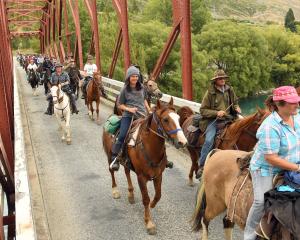Participants in next year's Otago cavalcade will be taking in new territory next year - Southland.
After the 16th Otago Goldfields Heritage Trust cavalcade finished with a parade in Waikouaiti on Saturday, organisers announced next year's event would finish in the eastern Southland town of Waikaka, near Gore,
‘‘We've almost done Otago to death over 16 years,'' said Roberta Laraman, who has co-ordinated 14 cavalcades.
During the 1800s, most of Southland, particularly the goldfields, had come under the leadership of Otago.
‘‘Even though we are the Otago Goldfields Heritage Trust, we still feel that we can do this because there is such a lot of gold history down there.''
Mrs Laraman, of Cromwell, said the cavalcade was ‘‘too good for Otago to lose''.
This year's event attracted 480 people to 10 different trails, either walking, riding or driving horse-drawn wagons. All the trails converged on Waikouaiti, with participants, many dressed in period costume for the gold rush days, finishing with a grand parade around the Waikouaiti Racecourse on Saturday.
Mrs Laraman has been trying to retire from the job for the past two years. With no-one yet stepping up to the post, she is worried the annual event may die or end up becoming commercialised.
Next year, Mrs Laraman will also be losing her right-hand woman, treasurer Kay Adam (79), who is retiring due to failing eyesight, after a 16-year involvement with the cavalcade.
Mrs Laraman said she was still trying to retire, but organisation for next year's cavalcade had already begun. However, the trust was looking at alternative plans, she said.
‘‘It is a very difficult thing to let go. It's been so much a part of my life. I don't want to see it highly commercialised because that puts the prices up and it becomes unaffordable for the average person.''
For those who joined the cavalcade, it was a unique experience, with the walkers, horse-riders and wagon drivers getting the opportunity to see ‘‘parts of our wonderful country that you and I never get the chance to see''.
Watching the final parade always brought her feelings of pride, along with relief everybody had made it home safely, Mrs Laraman said.
‘‘Every one of those people are all hurting somewhere, but they are all walking high and proud. The cavalcade is just too important to die, it really is.''
While it was a huge logistical exercise to organise, the cavalcade provided important fundraising opportunities for clubs and recreational groups, who took on roles such as providing all the meals, as well as bringing benefits for the host town.
It turned over about $200,000, most of which went back into the community for food and accommodation.
Twelve people this year completed their 16th cavalcade.


